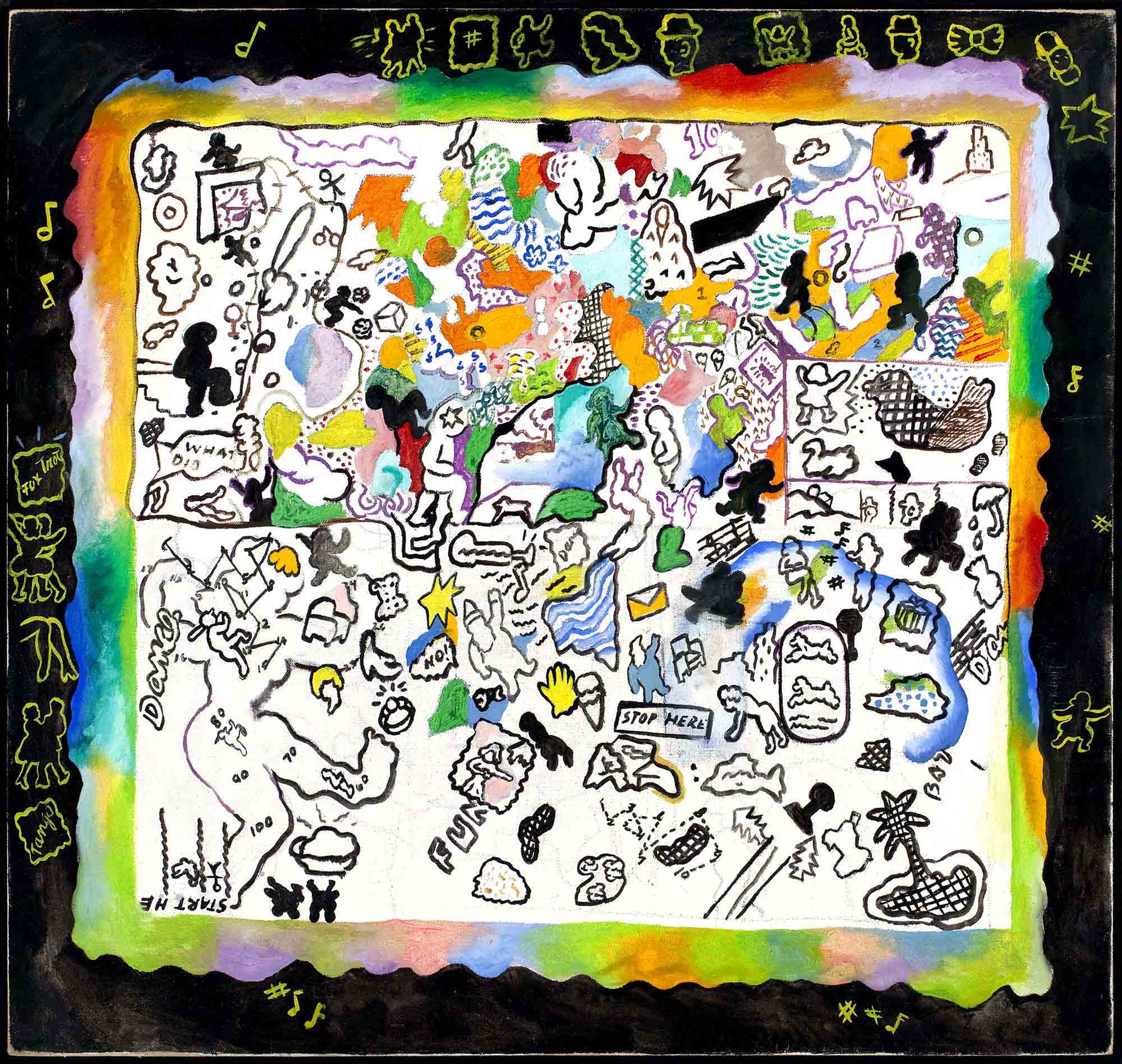
Suellen Rocca
Game
Surrounded by a black margin, on what seems like a collaged sheet of paper painted with watercolors, is a colorful game board actually painted with thinned oils on canvas. Clues to the game are painted on the margin, including music notes and dancing couples, as well as little framed words naming dance steps—fox trot and tango. Inside a colored, scalloped border, a multitude of little figures and symbols are outlined in black, some accentuated with bright colors. Commencing with a large dancing figure in the Start corner, cherubic figures seem to traverse the board—approaching a door, following a path, or stepping over water. A ring, an island with a palm tree, an ice cream cone, a baseball player, a dress with a paper-doll tab, an envelope, words and phrases like “fun” and “dance” and “what did,” and many other marks are strewn over the rollicking surface. A few perpendicular lines seem to define segments, but dissolve as the eye searches for a path implied with the commands “Start Here” and “Stop Here.” It’s not evident where and in what order to look or dance or find fun, but it’s clear that this is a happy game of action and discovery.
Like other images that Suellen Rocca painted during the 1960s, Game contains a personal language of glyphs that represent the many little pictures that surrounded her during childhood–in the pre-reader books of her kindergarten, in comics, in magazines, and in prevalent advertisements for such things as Arthur Murray dance lessons. As an adult and a mother of two young children, she was noticing and remembering the influence of graphic images on children—animals, dancing figures, food, clothing—and she painted them as simplified line drawings either in neat rows or in unruly abundance. She enjoyed connect-the-dots, mazes, and follow-the-numbers games and inserted some of these puzzles into her pictures. She also loved Surrealist art in which unrelated objects were juxtaposed by chance, and Egyptian art that was composed of pictographs.
Suellen Rocca
Suellen Rocca decided to be an artist when she was eight years old. “I was a good student. I always finished my work in plenty of time and then I would draw. When I was in third grade, my teacher collected all my drawings at the end of the class and hung them in the hall outside my classroom. It was my first exhibition! She called my mother and told her to sign me up for classes at the Art Institute of Chicago, which my mother did.” Rocca went on to earn her bachelor’s degree from the School of the Art Institute of Chicago in 1964 and exhibited as part of the Hairy Who exhibitions of 1966-68. Like her Imagist colleagues, her art was characterized by personal symbolism, careful technique, high color, and combinations of objects in a flat space. She is the Curator and Director of Exhibitions for the Department of Art at Elmhurst College, where she also teaches studio classes in painting, drawing and design.
Key Ideas
- Picture language that combines simplified images with painted words
- All-over design formed from images commonly seen during the artist’s childhood
- Personal symbolism as subject and content of a work of art
Discussion Questions
- What associations can you make with the overall image inside the colorful border? (Some ideas might include a postcard, a quilt, a coloring or comic book, and tattoos.)
- What do you think this game is about? What common theme might link the various elements? What stories can you create about the figures in segments of Game?
- What connections do you make with the title Game? What other titles can you imagine for this painting? What suggests these alternatives?
- If this image could be represented in a song, what kind of music would it inspire?
